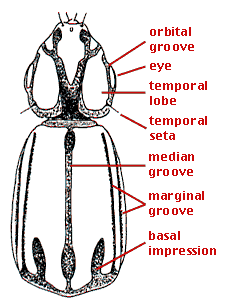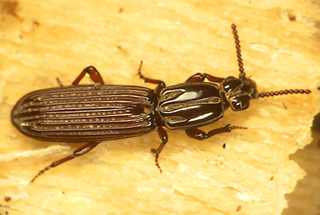Clinidium (Arctoclinidium)
Ross T. Bell.png?x=848883358)


This tree diagram shows the relationships between several groups of organisms.
The root of the current tree connects the organisms featured in this tree to their containing group and the rest of the Tree of Life. The basal branching point in the tree represents the ancestor of the other groups in the tree. This ancestor diversified over time into several descendent subgroups, which are represented as internal nodes and terminal taxa to the right.

You can click on the root to travel down the Tree of Life all the way to the root of all Life, and you can click on the names of descendent subgroups to travel up the Tree of Life all the way to individual species.
For more information on ToL tree formatting, please see Interpreting the Tree or Classification. To learn more about phylogenetic trees, please visit our Phylogenetic Biology pages.
close boxIntroduction
Arctoclinidium is a holarctic subgenus with nine species, five from the eastern U.S. and one each from western North America, Japan, the Caucasus, and southern Europe.
Characteristics
The base of the anterior tarsus is opposite of the cleaning organ. The antennal stylet is small. Tufts are present on antennal segments VI-X (C. veneficum) or VII-X (all other species). The number of temporal setae is 1 or 0. The eye is crescentic. The orbital groove is complete and joined posteriorly to the marginal pollinosity of the temporal lobe.


Dorsal aspect of head and pronotum of Clinidium (Arctoclinidium) valentinei.
Modified from Bell and Bell (1985). Copyright © 1985 Ross T. Bell and Joyce R. Bell.
The marginal groove of the pronotum is double or single. The angular seta is absent (except in C. marginicolle). There are no marginal setae. The marginal stria of the elytron is the sixth from the suture. The inner intervals are convex or costate. There are very few elytral setae restricted to the posterior part of the elytron. The female has enlarged lateral pits on sternum III or IV or both III and IV.
References
Bell, R. T. and J. R. Bell. 1985. Rhysodini of the World Part IV. Revisions of Rhyzodiastes and Clinidium, with new species in other genera (Coleoptera: Carabidae or Rhysodidae). Quaestiones Entomologicae 21(1): 1-172.
Title Illustrations

| Scientific Name | Clinidium baldufi |
|---|---|
| Location | Mississippi, U.S.A. |
| Specimen Condition | Live Specimen |
| Image Use |
 This media file is licensed under the Creative Commons Attribution License - Version 3.0. This media file is licensed under the Creative Commons Attribution License - Version 3.0.
|
| Copyright |
© 1997 David R. Maddison

|
About This Page
Ross T. Bell

University of Vermont, Burlington, Vermont, USA
Page copyright © 2000 Ross T. Bell
All Rights Reserved.
- First online 01 March 2000
Citing this page:
Bell, Ross T. 2000. Clinidium (Arctoclinidium). Version 01 March 2000 (under construction). http://tolweb.org/Clinidium_%28Arctoclinidium%29/1812/2000.03.01 in The Tree of Life Web Project, http://tolweb.org/







 Go to quick links
Go to quick search
Go to navigation for this section of the ToL site
Go to detailed links for the ToL site
Go to quick links
Go to quick search
Go to navigation for this section of the ToL site
Go to detailed links for the ToL site